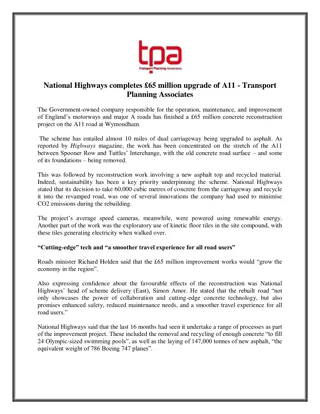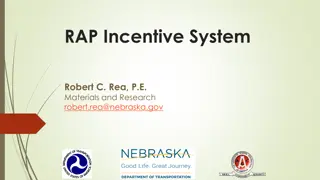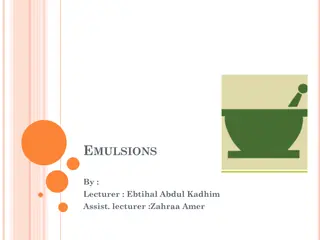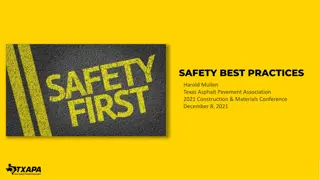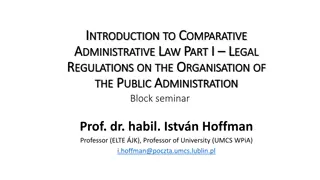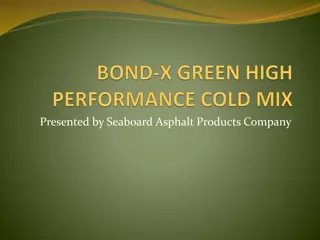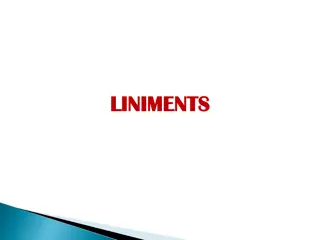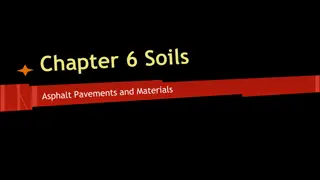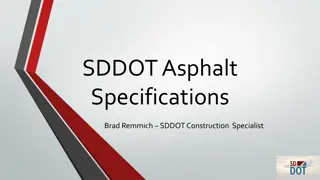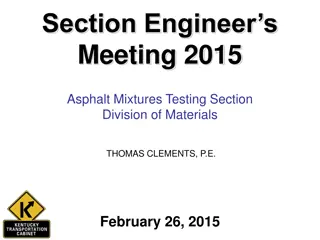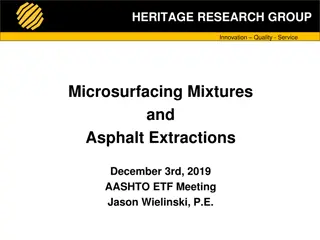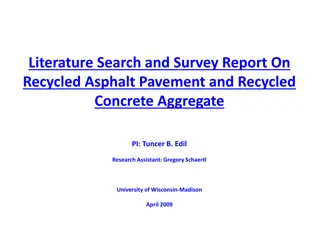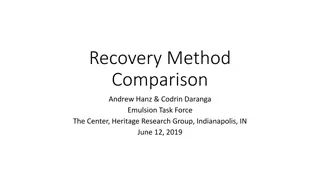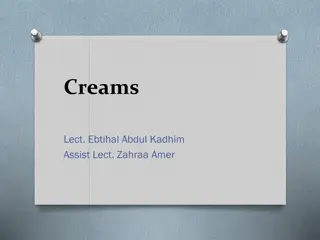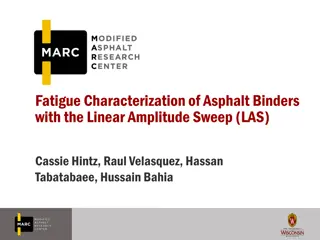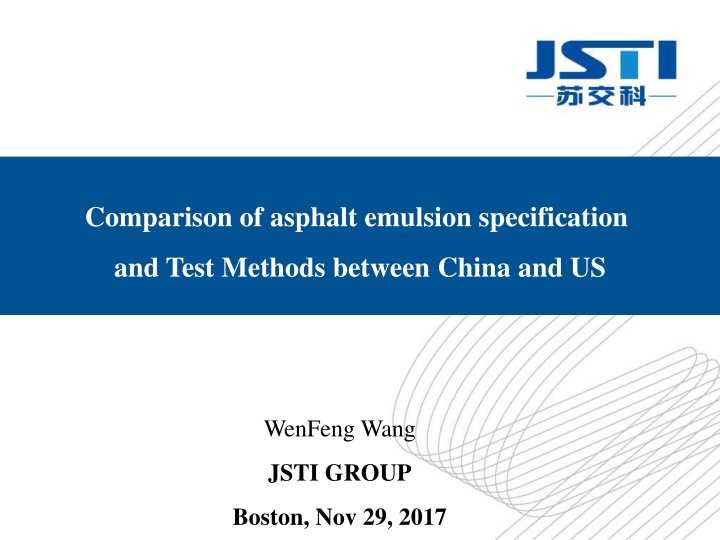
Asphalt Emulsion Specification and Test Methods Comparison: China vs. US
This comparison discusses the classification standards, specification differences, and test methods for asphalt emulsions between China and the United States. It covers important aspects such as demulsification speed, setting types, viscosity, penetration of residue, and application classifications. The document outlines the variations in classification standards, specifications, and test practices for asphalt emulsions in both countries, shedding light on their unique approaches and criteria.
Download Presentation

Please find below an Image/Link to download the presentation.
The content on the website is provided AS IS for your information and personal use only. It may not be sold, licensed, or shared on other websites without obtaining consent from the author. If you encounter any issues during the download, it is possible that the publisher has removed the file from their server.
You are allowed to download the files provided on this website for personal or commercial use, subject to the condition that they are used lawfully. All files are the property of their respective owners.
The content on the website is provided AS IS for your information and personal use only. It may not be sold, licensed, or shared on other websites without obtaining consent from the author.
E N D
Presentation Transcript
Comparison of asphalt emulsion specification and Test Methods between China and US WenFeng Wang JSTI GROUP Boston, Nov 29, 2017
OUTLINE 1. Classification Standard of Asphalt Emulsion (AE) 2. Specification Comparison 3. Test methods and criterion
Classification standard of AE US ASTM D997----Demulsification speed Rapid Setting----RS-1, RS-2 Viscosity Middle Setting----MS-1, MS-2, MS-2h Slow Setting----SS-1 SS-1h Penetration of Residue Quick Setting----QS-1h ASTM D2397----Cationic asphalt emulsion CRS-1, CRS-2, CMS-2, CMS-2h, CSS-1, CSS-1h, CQS-1h ASTM D3628-----Selection and Use of AE
Classification standard of AE China JTG F40-2004 Demulsification speed, Application Classification Code PC-1 PC-2 PC-3 BC-1 PA-1 PA-2 PA-3 BA-1 Nonionic emulsified asphalt Demulsification Rapid Slow Rapid or Middle Slow or Middle Rapid Slow Rapid or Middle Slow or Middle Slow Application surface seal coat layer oil tack coat Slurry Sealing, Cold Mix Asphalt surface seal coat layer oil tack coat Slurry Sealing, Cold Mix Asphalt layer oil Cationic emulsified asphalt Anionic emulsified asphalt PN-2 BN-1 Slow Base reclamation China: classified by demulsification speed, and then the scope of application is used as the classification standard.
Specification comparison Specification comparison China US Specification for asphalt emulsion JTG F40-2004 ASTM AASHTO Asphalt Emulsion(AE) Table 4.3.2 D977-13 M140-16 Polymer modified AE M316-16 Cationic AE D2397-13 M208-16 Rapid setting AE M81-92(2012) Middle setting AE M82-75(2012) Micro surfacing MP8-16 Chip seal MP27-16 AASHTO made specifications according to the type of emulsion In China, the specification for asphalt emulsion is named F40 which was published in 2004.
Specification comparison Standard practice comparison US Standard Practice China ASTM AASHTO R5-13 Usage and selection sampling R66-16 Certified supplier R78-16 Specification for chip seal MP27-16 Design for chip seal PP82-16 Design for Micro surfacing PP83-16 Emulsion recycling agent D5505-14 Mixing property D6999-12 Low temperature evaporation residue D7497(2016) Vacuum oven recycling residues D7944-15 Specification and practice D244-09 T59-16 Freezing thawing effect D6929-16 Standard practice of Cation Recognition D7402-09 The work of standard practice is lacking in China
Specification comparison Standard Test Methods comparison China US Test specification JTG-E20-2011 ASTM AASHTO Demulsification speed T0658-1993 D6936-09 T59 Standard T0621-1993 Angler T0622-1993 viscosity Saybolt T0623-1993 D7496-11 T72-10(2015) Dynamic / D7226-13 Evaporation T0651-1993 D6934-08 (2016) T59 Evaporation residue Distillation / D6997-12 T78-15 Sieve residue T0652-1993 D6930 T295-13 density / D6937-16 particle size / D6933-13
Specification comparison Standard Test Methods comparison China E20 T0653-1993 US Test specification ASTM D244 AASHTO T59 Ionic charge Aggregate adhesion T0654-2011 D244 T59 room T0655-1993 D6930 T59 temperature storage stability low temperature T0656-1993 D244 T59 cement T0657-2011 D6935-11 T59 Mixing property aggregate T0659-2011 Mixing with water T0655-2011 D244 T59 Draft water content(distillation) D244 T59 In China, many test methods has been using since the year of 1993
Test specification and Requirement Viscosity Test specification U.S----ASTM Saybolt viscosity, Rotational viscosity Rapid setting and middle setting: 50 Slow setting and quick setting: 25 China Angler viscosity: E25,25 Standard viscosity C25,3,25 In China, spray emulsion that is usually applied at 50 , the test temp is not very suitable.
Test specification and Requirement Viscosity Criterion US Quick Setting Test Rapid Setting Middle Setting Slow Setting Category temperature CSS- 1 CRS-1 CRS-2 CMS-2 CMS-2h CSS-1h CQS-1h 25 50 25 / 20~100 / 45~220 Saybolt viscosity Rotational viscosity mpa.s s 20~100 100~400 50~450 / 50 45~220 220~880 110~990 / China Spraying Mixing Category PC-1 PC-2 PC-3 BC-1 Test temperature Standard viscosity Angler viscosity C25 3 10~25 8~20 8~20 10~60 s 25 2~10 1~6 1~6 2~30 The criterion of viscosity between US and China has a large of differences because of the test requirement
Test specification and Requirement Residue recovery method Test Requirements US---ASTM D6934/D6997/ASTM D7497: Method B Distillation: 260 15min Decompressing distillation: 135 60 6hr Thin Film silicone Mat China----JTG E20 T0651 Heated by conventional electric stove No definite test temperature in the process 163 3 , 1min, after confirmation of no water US: Evaporation Distillation Low temp Evaporation China: still retain Evaporation Influenced by many factors, Poor reproducibility, Aging risk
Test specification and Requirement Residue Criterion US Cationic emulsified asphalt Category Residue content % Penetration 25 0.1mm Ductility 25 cm Solubility % , Quick Setting CQS-1h Rapid Setting Middle Setting Slow Setting CRS-1 CRS-2 CMS-2 CMS-2h CSS-1 CSS-1h 60 65 57 100~250 40~90 100~250 40~90 40 97.5 Reclassification by residual content and penetration
Test specification and Requirement Residue Criterion China Cationic emulsified asphalt Category Residue content % Penetration 25 0.1mm Ductility 15 cm Solubility % Spraying PC-2 Mixing BC-1 PC-1 PC-3 50 50 50 55 50~200 50~300 45~150 40 97.5 The largest difference is residue content Ductility and solubility refer to ASTM standards
Test specification and Requirement Aggregate adhesion Test Requirements US Aiming at middle setting AE Mixing 5min, take half to observe the adhesion, The other half is washed with water to observe the adhesion China Soak in water for 1 min. Soak in AE for 1 min, Take out and hang it for 24h at room temperature. Then boiled it at 100 . Take out and observe the adhesion U.S: Pay attention to adhesion performance during mixing China adopts water boiling method, similar to hot asphalt, refer to Europe standard.
Conclusion 1. Update current Chinese asphalt emulsion specifications and practice and test methods Promote low temperature evaporation Develop varied specifications, design methods and best practice of asphalt emulsion for different pavement preservation treatments 2. Keep up with SPG/EPG 3. Make efforts towards to performance related specification
Thank you ! Wenfeng Wang wwf35@jsti.com

